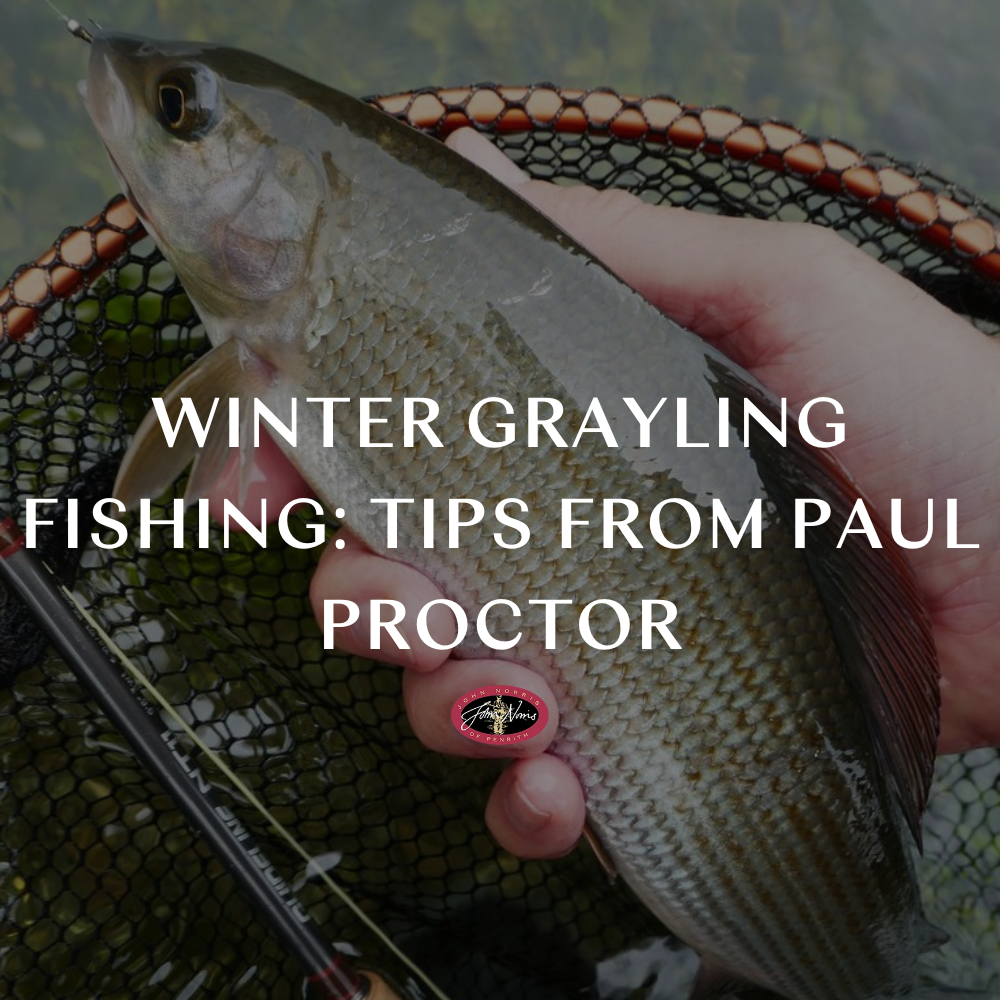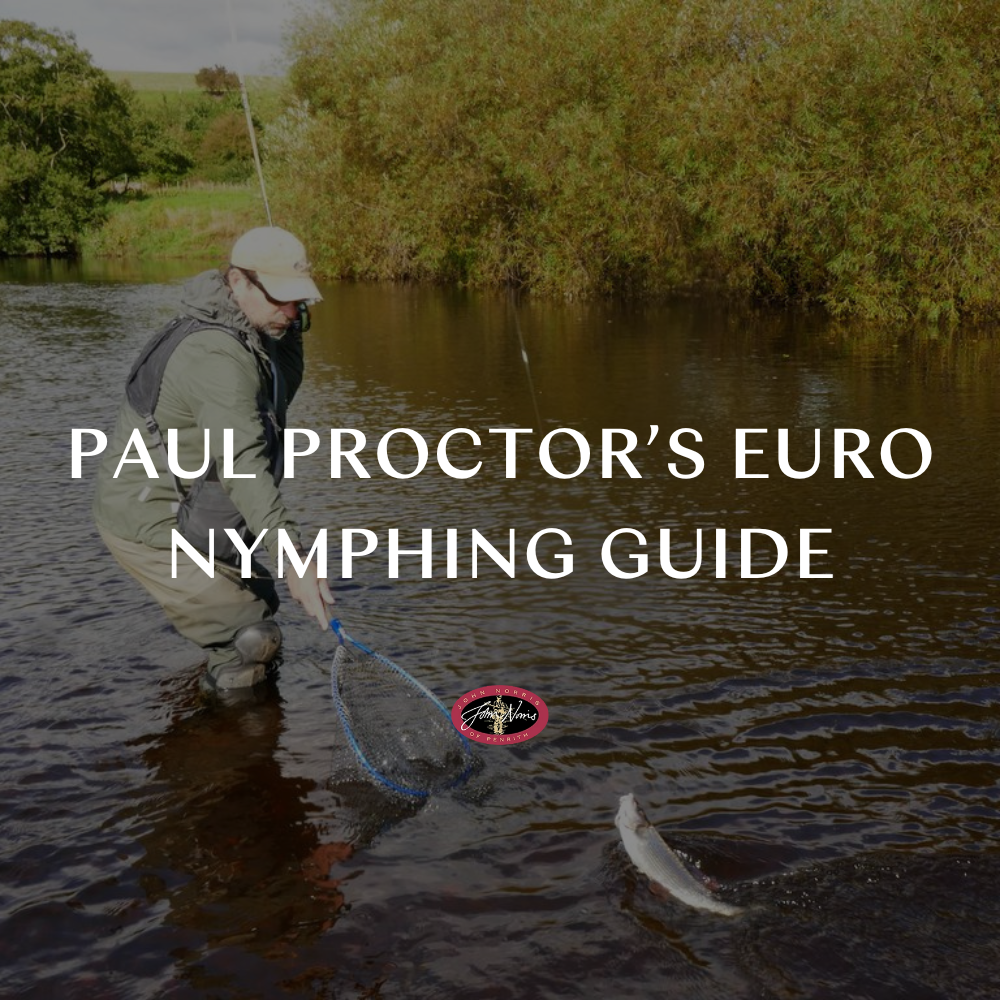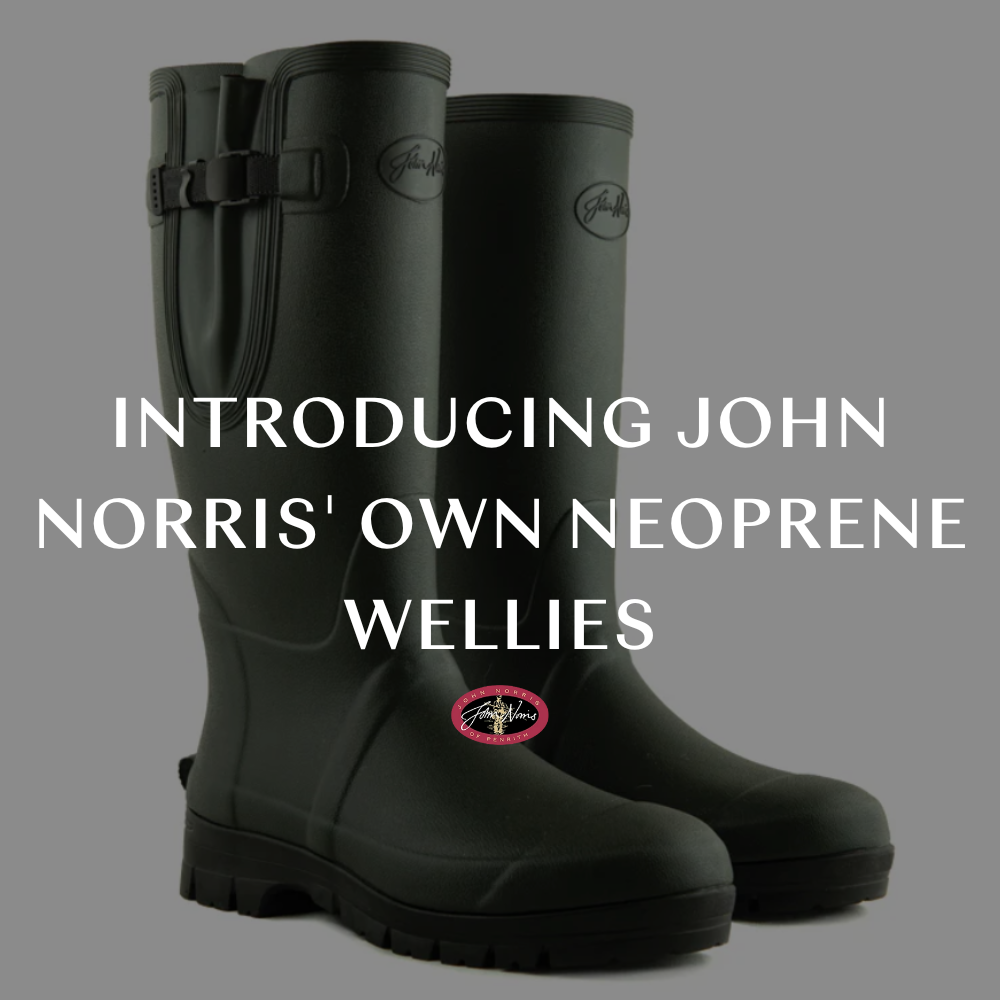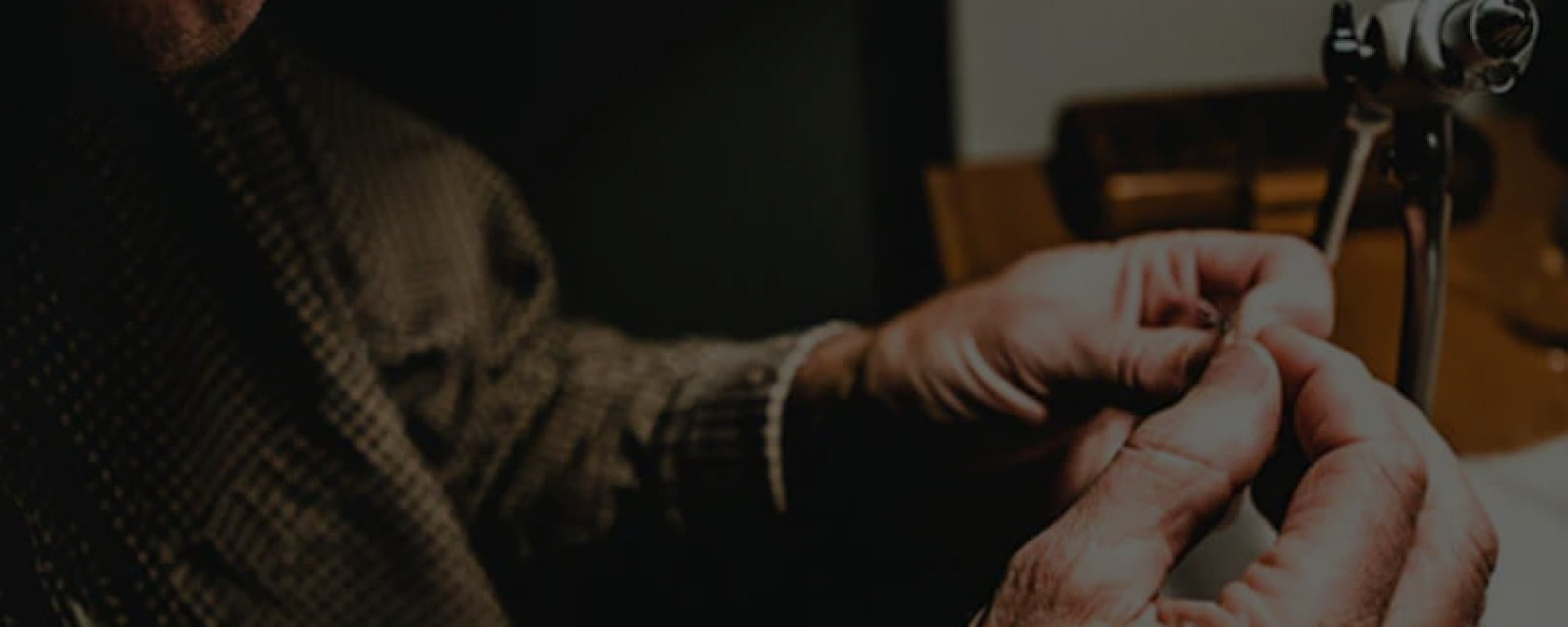Winter Grayling Fishing: Tips from Paul Proctor

With the brown trout season drawing to a close, our focus shifts to grayling, which seem most active during the colder months. Grayling have always held sway with anglers in the North, and they’re as popular as ever today. A spot of grayling fishing extends the season, giving us that much-needed ‘fix’ through winter.
The seasoned rod will be familiar with the elegant, streamlined profile of grayling, their preferred lies, and the food they choose to eat. Yet, for those venturing into the unknown world of flowing water, the experience may initially seem daunting. There’s often a mix of anticipation and trepidation as beginners wade out for the first time.
Here, our resident guide Paul Proctor shares practical tips and advice to help you get the best from the months ahead.
Grayling
Grayling are instantly recognisable by their striking dorsal fin, ‘V’-shaped tail, and unmistakable underslung mouth. Because they share the same spawning season as coarse fish, their status as a game fish has sometimes been questioned.
Yet the very fact that they thrive in the same well-oxygenated waters as trout, possess an adipose fin, and willingly accept artificial flies firmly establishes grayling as a true game fish. Their underslung jaw suggests much of their diet is taken close to the stream bed, though they are also notorious ‘free-risers’, giving us plenty of opportunities with dry flies.

Where to Look for Grayling
Renowned for thriving in swift currents, grayling can also be found in slower glides and deep runs. At rest they normally position themselves close to the streambed, away from energy-sapping flows. Extremely cold temperatures and high water will see them hugging the substrate.
Like trout, grayling have preferred areas for feeding. Though gregarious by nature, I think of a grayling’s feeding lie more as a communal affair, when several fish might occupy the same favourable place at once. I’ve watched fish move into the shallower neck of a pool to feed when nymphs are expected to ascend. Equally, when lots of terrestrials are about, namely aphids or black gnats, grayling often take up station in the slower pool body or tail where a glassy surface exists.
Following spawning and throughout summer, grayling disperse themselves widely (this is the case on my home waters in Cumbria). However, plummeting water temperatures in autumn will see the fish revert to their customary shoaling tendencies once more.

What Rod?
Generally speaking, most grayling you’ll encounter will fall into the ¾–1½lb bracket, with a fish of 2lb exceptional and one over 3lb very special indeed. That doesn’t mean they fight any less. Pound for pound, grayling give an impressive account of themselves, especially when using that huge dorsal fin like a sail to head downstream of you.
In my mind, stiff rods have no place on rivers. Instead, look to one with a medium action that yields when fish are hooked at close quarters and flexes more easily when casting short lines or using euro-nymphing techniques. To combat swirling currents using mends, a longer rod is definitely more beneficial. The Guideline NT11 9’9” 4-weight, or Tactical LPX 9’9” 4-weight, make ideal companions for winter grayling.

Weight Forward or Double Taper Fly Line?
Providing delicate presentation, many river anglers historically favoured double-tapered lines, and I’ve periodically used them myself. However, most river fishing takes place at close quarters, seldom more than 20–30 feet away. Weight-forward (WF) lines generally have a head/belly length of this, making them perfect for river work.
What’s more, modern WF profiles tend to possess refined front tapers, so they land like thistledown, ideal for dry fly fishing. Granted, there’s a bewildering selection of fly lines available today, but you won’t go far wrong with the Guideline Presentation Plus.
What Fly Life to Expect
Granted, fly life might be starting to shut down for winter, but autumn can throw up an incredible amount that summons grayling to the surface. Believe it or not, one of our most beloved upwing species, the Blue-Winged Olives (B-WOs), remain active throughout October and even November. Large Dark Olives and Pale Wateries will also feature.
Expect flurries anywhere from late morning through to dark, with early afternoon the prime window. A size 14/16 F Fly or olive paradun will have you covered here. Willow flies and needle flies (small stoneflies) will also be evident on warm, still days, especially when females return to egg-lay. You won’t go far wrong with a small hare’s ear or brown F Fly
There’s also an outside chance of black gnats being on the menu. When they appear, these tiny terrestrials often swarm in huge numbers and are best copied with a size 14–16 Procter’s APT or Black Klinkhamer.

Think Dry Fly
With all this talk of hatches, dry fly fishing should rightly occupy our minds. Regardless of what fly you choose, a decent leader arrangement is vital. A tapered leader of 9–12ft provides the dynamics for delicate, stable presentation.
If you buy either a 9ft or 12ft taper that terminates in 5X, like the Guideline Powerstrike leaders, you can simply knot a fly on the end. However, I’d urge you to add at least a couple of feet of level tippet (approx. 3–4lb breaking strain) using a tippet ring, or by a 3-turn water knot. This extra length vastly improves your presentation and drifts.
And if you’re nervous about using a leader longer than 12ft, trust me, you’ll be surprised how quickly you adapt. After all, the idea is not for perfect straight-line turnover, but instead for the leader to land in a series of small wiggles, which allows your fly to drift drag-free for longer.

Give Spiders a Whirl
North Country wet fly, or spider fishing, is a recognised way of tempting fish that aren’t rising. The beauty of this method is that you’re making an effective blanket sweep of the river when searching for grayling.
A team of three spiders, positioned 3ft apart on a 12ft leader, is probably the best arrangement. If you’re unsure about casting three flies, then two flies spaced 4ft apart will suffice.
Wet fly fishing in its truest sense is practised facing upstream. However, conditions need to be nigh on perfect for this. A better approach is often to allow currents to usher your flies downstream on a slightly tensioned line. Cast square across and elevate your rod tip to about 45 degrees. This slows your flies and makes them fish more naturally, while the bowing line off your rod tip acts as an indicator. If it lifts or hesitates, in all likelihood a fish has seized one of your flies.
When it comes to patterns, it’s wise to offer three different spiders. A good starting point would be Black Magic on the top dropper, Waterhen Bloa on the middle, and Snipe & Purple on the point. Other favourites include Partridge & Orange, Woodcock & Yellow, and Greenwell’s Spider.

Get Bugging
The winter months see all manner of aquatic invertebrates developing on the riverbed. Cased and caseless caddis, shrimps, baetis nymphs and stoneflies are all present, though often hidden away. Any lift in water levels can flush them out, presenting them to waiting grayling.
Bugging, or nymph fishing, often dominates our approach during the colder months. Perhaps the most effective is ‘euro-nymphing’ (short, fixed-line nymphing). This technique uses only monofilament to deliver and guide your bugs along the streambed. Shop-bought euro-leaders and French leaders are very convenient these days.
I’ll often tie on one or two nymphs, spaced around 12 inches apart. These are ‘lobbed’ upstream and gently guided back on a tensioned line with a raised rod tip. Part of the leader is brightly coloured to act as an in-line indicator. Any hesitation or deviation should be met with a firm lift. Yes, you’ll occasionally hook the streambed, but you’ll be surprised how often the rod bucks into life with a hooked grayling.
Where depth prevents wading, or when fish are holding at range, a conventional 9ft leader of level 5–6lb nylon is better, as it sinks more readily than a tapered leader. Position your nymphs 12–18 inches apart and add a yarn, foam, or polystyrene ball indicator at the junction of fly line and leader.
Using a slow, wide casting stroke maintains tension and allows the rig to cover a fair distance. Strikes are best made sideways, which keeps tension on the nymphs. A vertical lift only takes up slack and curves in the line.

The colder months might shorten the days, but grayling more than make up for it. Whether you’re coaxing them on dries, swinging spiders, or guiding nymphs through winter flows, these elegant fish offer sport that keeps us on the water long after trout season has ended. This instalment is just one part of our seasonal guest blog series, offering timely tips from expert Paul Procter to improve your fishing year-round.
For guidance, hand-picked tackle, and all you need to fish with confidence, John Norris is your trusted partner both in-store and online.











